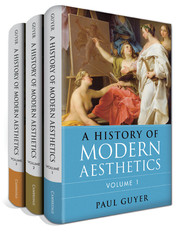Book contents
- Volume 1 The Eighteenth Century
- Frontmatter
- Epigraph
- Contents
- Acknowledgments
- Introduction
- 1 Prologue
- Part One Aesthetics in Britain, 1725–1800
- Part Two French Aesthetics in Mid-Century
- Part Three German Aesthetics between Wolff and Kant
- Part Four Kant and After
- 9 Kant
- 10 After Kant
- Bibliography
- Index
- Volume 2 The Nineteenth Century
- Volume 3 The Twentieth Century
- References
9 - Kant
from Part Four - Kant and After
Published online by Cambridge University Press: 05 June 2015
- Volume 1 The Eighteenth Century
- Frontmatter
- Epigraph
- Contents
- Acknowledgments
- Introduction
- 1 Prologue
- Part One Aesthetics in Britain, 1725–1800
- Part Two French Aesthetics in Mid-Century
- Part Three German Aesthetics between Wolff and Kant
- Part Four Kant and After
- 9 Kant
- 10 After Kant
- Bibliography
- Index
- Volume 2 The Nineteenth Century
- Volume 3 The Twentieth Century
- References
Summary
In the Critique of the Power of Judgment, published in 1790 as the last of his three great critiques, Immanuel Kant defined our feeling of pleasure in beauty as the “sensation of the effect that consists in the facilitated play of both powers of the mind (imagination and understanding), enlivened through mutual agreement.” Such pleasure, Kant insisted, does not yield any determinate knowledge about its object but expresses “nothing but its suitability to the cognitive faculties that are in play in the reflecting power of judgment, insofar as they are in play.” With such statements, Kant seems to have completely rejected the traditional analysis of aesthetic experience as a distinctive mode of access to truth and to have accepted without reservation the account of aesthetic experience as a form of intrinsically pleasurable mental activity, with no external reference to truth and no need of such reference to justify its value, that had been introduced by such British writers as Alexander Gerard and Lord Kames and at least hinted at by several Germans, in passing by Moses Mendelssohn and more explicitly by Johann Georg Sulzer. Indeed, by apparently analyzing the experience of beauty solely in terms of the free play of our cognitive powers and entirely rejecting the traditional aesthetics of truth, Kant seems to have introduced a new, distinctively modern epoch in aesthetic theory. He was thus interpreted, for example, by Hans-Georg Gadamer, in his famous charge that Kant had “subjectivized” modern aesthetics.
- Type
- Chapter
- Information
- A History of Modern Aesthetics , pp. 421 - 458Publisher: Cambridge University PressPrint publication year: 2014
References
- 2
- Cited by



